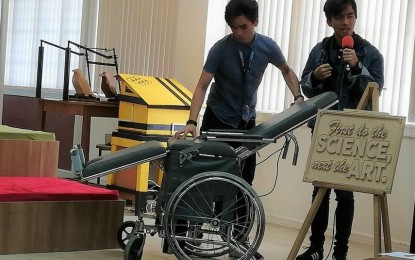By Liza Agoot with with a report from Michael Jerome de Guzman, OJT/Philippine News Agency

BAGUIO CITY — The trend for future engineers is changing and Baguio’s biggest and oldest university, Saint Louis University (SLU), is adapting as it geared towards producing more scientists from the field of engineering.
“It is a high breed subject. A mixture of technology plus entrepreneurship. We aim to produce a new breed of engineers come 2024 who are not just thinking of their own technical expertise but what can the technology do to the community and earn from it,” said Architect Donna Tabangin, professor at SLU School of Engineering and Architecture (SEA), the innovator of the SLU Incubator for Research Innovation and Business (SIRIB) Center during a press conference on Wednesday.
SIRIB is an Ilocano word which means “intellect”.
The press conference on Wednesday was also a venue to show the prototype of functional technologies developed by SEA students through the SIRIB center.
Tabangin said she got the idea of putting up a SIRIB center when she was on a scholarship at Berkeley University in California in 2016.
The concept of the SIRIB center is for students to come up with ideas on technology that will address actual problems of the community and make a functional prototype at the Fabrication Laboratory (FabLab) that can be marketed.
The setting up of the SIRIB center was made possible through a PHP31 million partnership with the Commission on Higher Education (CHED), Department of Trade and Industry (DTI) and the Department of Science and Technology (DOST).
Cynthia Posadas, Dean of the School of Engineering and Architecture (SEA) of SLU, said the subject “Technopreneurship 101” is a mandate of the CHED, mandating a transition to the K-12 curriculum lowering from five to four years the Engineering program, and offering the said subject.
“All engineers who will graduate will have a technopreneurship mindset. While it does not mean they will all go to the track but as much as possible, that’s what we’re supposed to believe ourselves to the mindset of technopreneurship, another direction of the career of engineers and architects,” Posadas said.
She added that all students under the SEA are required to get the three-unit subject composed of two units lecture, where students will come up with ideas, and one unit laboratory, where students will make a functional prototype of the idea at the FabLab.
“It’s part of curricula across all disciplines under the SEA,” she said.
By 2024, around 2,000 engineering graduates of SLU are potential scientists and technopreneurs.
New inventions
There were six prototypes of technologies that are ready for patenting and marketing–one of which is the “modified wheelchair”, which has been developed by Mechatronics Engineering students.
Prince William Lim, a 5th-year Mechatronics Engineering and one of the creators of the modified wheelchair, said their aim is to make the work of doctors and nurses handling patients easier.
It is like a wheelchair that can lift itself to the level of a medical bed to make it easier for a patient to be transferred.
Lim said the chair can flatten itself to become a bed, similar to that of a recliner or a foldable sofa bed.
Lim added that the prototype would remove the need for carrying patients to either the chair or their bed.
He said in collaboration with the Nursing Department of the university, the prototype is still undergoing further testing.
Another prototype that is ready for marketing is the “Dupli-Carving machine”.
JC Vincent Aquino, one of the inventors, said the machine is a collaboration with fellow students the machine is still manually operated but it helps with increasing the speed, by which sculptures are made.
It can help mass produce sculptures and wood-carved items, duplicating or copying an existing, making an exact copy of the original.
Another prototype is a technology that can be used in agricultural greenhouses where sensors are placed and self-assessment of the machine of the dryness of the soil will in itself water the plants.
The “Modular Drone” was adapted by Aboitiz company to be used in surveying an area without the need to deploy personnel to a site, reducing the chance of endangering the safety of the workers.
Compared to the regular drone already sold in the market, the students’ prototype is capable of showing a three-dimensional view of an area, complete with the height of an object, distance and the geography of the location.
As the drone is modular, the parts can be replaced easily with updated technology. The equipment can also be replaced without the need to return it to the manufacturer.
For the latest updates about this story, visit the Philippine News Agency website
